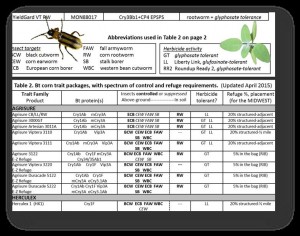— by Dr. Jeff Whitworth, Dr. Holly Schwarting and J.R. Ewing
There has been much activity this year by this particular insect, starting in whorl stage corn and moving to sorghum (both whorl and heading stages) and now in soybeans.
Likewise, there has been some concern that all this activity and resultant insecticide applications have cause an increase in insecticide resistant Helicoverpa zea populations. So, thanks to great effort on the part of Ethan Kepley, consultant in south east Kansas, who collected all the Helicoverpa zea larvae in one morning from an untreated soybean field, and Steve Freach, FMC, who was kind enough to transport all the larvae directly from the field to our lab, it was possible to conduct a bioassay. The results of this insecticide bioassay are shown below.
Approximately 300 corn earworm/soybean podworm/sorghum headworm, Helicoverpa zea (Boddie), were collected from an untreated soybean field in south east Kansas. Larvae (mixed sizes but predominantly relatively large instars, which are known to be more difficult to kill quickly) were equally divided into 6 treatments (Table 1). Larvae were placed individually in small petri dishes that had been coated with the selected insecticide at the rate listed and set aside to dry for 4 hours prior to adding the larvae. All treatments were individually evaluated 24 hours after the larvae were placed in the petri dishes. Larvae were evaluated as live: no apparent effect; moribund: larvae very sluggish, little or no movement unless prodded and then only very slow, unnatural movement, and; dead: no movement even when prodded. From this bioassay there does not appear to be any insecticide resistance to those insecticides and rates utilized (Table 1).
| Treatment | % of Larvae Live | % of Larvae Moribund | % of Larvae Dead |
| Hero @ 6 oz/a | 0 | 3.4 | 96.6 |
| Lorsban @ 2 pts/a | 0 | 8.6 | 91.4 |
| Mustang Maxx @ 4 oz/a | 0 | 10.9 | 89.1 |
| Baythroid @ 2.8 oz/a | 0 | 15.5 | 84.5 |
| Warrior II @ 1.6 oz/a | 0 | 3.4 | 96.6 |
| Untreated | 87.5 | 9.4 | 3.1 (parasitized) |

